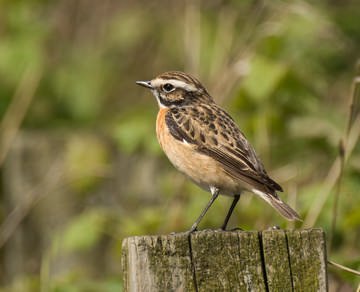Whinchat (Saxicola rubetra)

Whinchat © Sue & Andy Tranter
Every Cheshire ornithologist since Coward has reported the decline of the Whinchat. Boyd (1951) wrote that their ‘numbers are limited – fewer than twenty years ago’. Hardy (1941) stated that the species was becoming scarcer as a nester. Griffiths and Wilson (1945) commented ‘there has evidently been a considerable reduction in the breeding population’. Our First Atlas found them breeding sparsely along the Mersey valley and south of Chester, with a few in the eastern hills and odd scattered records elsewhere, but reported that during the period of the fieldwork (1978-84) they were declining further in their regular areas. Fewer were found after the end of the intensive atlas fieldwork, and, according to the annual bird reports, odd pairs were found at various Cheshire sites until the last confirmed breeding in 1991.
During this survey there were just four records of confirmed or probable breeding: one nest was found in 2005, at Frodsham Marsh (SJ57E) – the first known breeding in the county for fourteen years – and pairs were recorded at three other sites. Far more Whinchats pass through the county than ever stay to breed, and the atlas map is dominated by records of birds on passage: they usually turn up in areas of apparently suitable habitat, and merit an ‘H’ code, but almost all of them quickly move on. Most birds arrive in May and lone migrants can be found well into June in many years. If they stay to breed, chicks seldom hatch much before mid-June, and often later.
Whinchats perch prominently and feed on insects caught on the ground or in short sallies, with their main targets being beetles, flies, spiders and the larvae and adults of butterflies and moths. This is a chat found in open grassland, meadows and the youngest stages of plantations or open scrubland; it seems to be one of the few species that actively favours areas of bracken. Of the habitat codes submitted for 17 of the records in this survey, 9 were in farmland (equally split between improved grassland, unimproved grassland and tilled land), 3 in semi-natural grassland, 2 on saltmarsh, and 3 in scrub. Their decline has long been ascribed to mowing of roadside verges and tidying of rough ground (BTO First Atlas) and the loss of marginal farmland habitats (Marchant et al 1990). It might be thought that land set-aside from agricultural production would prove suitable, but apparently not.
This species and its close relative the Stonechat neatly illustrate two strategies for an insectivorous bird to cope with the British winter. Whinchats face the problems of a long migration and the potential hazards of winter in Africa while their cousins, Stonechats, try to stick it out in Britain, suffering in hard winters, or migrate shorter distances. Whinchats breeding in western Europe migrate to winter in the guinea savannah grasslands and the savannah/ forest mosaic from the south of Senegal to the Gulf of Guinea coast, eastwards as far as Cameroon (Birds of Africa). British birds probably inhabit the western part of that range, although no British-ringed bird has been found south of the Sahara (Migration Atlas). They have not noticeably suffered from the Sahelian droughts, wintering south of that area and presumably being able to lay down sufficient reserves to cross the widening Sahara desert.
![]() One Whinchat was seen during the winter Atlas period, on 21 November 2004 at the Gowy Marshes (SJ47G). This is the third November record in Cheshire and Wirral, following birds in the Frodsham area on 3 November 1984 and 13 November 1989. Autumn passage is usually complete by mid-October with later October records in just eight years since 1970.
One Whinchat was seen during the winter Atlas period, on 21 November 2004 at the Gowy Marshes (SJ47G). This is the third November record in Cheshire and Wirral, following birds in the Frodsham area on 3 November 1984 and 13 November 1989. Autumn passage is usually complete by mid-October with later October records in just eight years since 1970.
Sponsored by Andy Coxon

